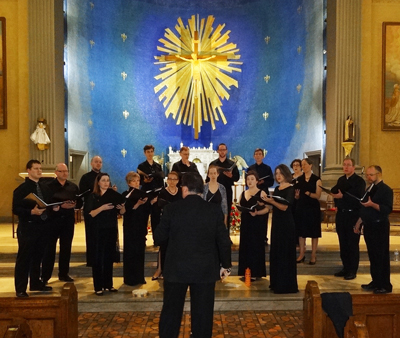by Nicholas Jones

Spanish music can seem the forgotten step-child of the Renaissance, overshadowed by the Italians, the French, and the Netherlanders — the latter of which the Spaniards did their best to subdue with their armies. But the cathedrals and courts of 16th-century Spain fostered a culture of singer-composer-organists that rivaled other nations’. Their polyphonic music was largely sung not in Spanish but in Latin — the common language of Christian Europe.
Arguably the greatest of the Spanish polyphonic composers was Tomas Luis da Victoria, a composer in the imperial court of Madrid who traveled to Rome to study with the great Giovanni Pierluigi da Palestrina and returned to Spain to outdo his teacher in expressivity and intensity. (The program notes for Contrapunctus concerts are exceptional in their full and engaging detail, and I’m indebted to them for this background, and much else that enhanced the concert.)
Two moving pieces by Victoria opened the concert. The motet O quam gloriosum (“How glorious is the reign of Christ and his saints”) demonstrated the vocal mastery of this choir from its opening moment: a perfect chord of open fifths and octaves, pulled, as it were, out of the air. The audience picked up on the beauty of the sound from the first, and refrained from applause until the end of the first half of the concert.) The motet was followed by five movements from Victoria’s Requiem Mass (Officium defunctorum), a six-part masterpiece written for the funeral of the dowager Empress Maria in 1603.
Here, episodes of Gregorian chant set off passages of rich and flexible polyphony, just as the music alternates between the tensions of the requiem text — moving from the terrors of judgment (Dies irae) to the joys of the blessed soul at rest (lux perpetua luceat eis). A final Kyrie (originally part of the Libera me section, but here sung on its own in this abbreviated presentation) was notable for its evocation of peace after the torments of death.
The fervor of Spanish devotion is evident in motets by Francisco Guerrero (remarkable, as the program annotations pointed out, for having made an arduous pilgrimage to Jerusalem — and being twice robbed by pirates on the journey home). His O Domine Jesu Christe, a contemplation of Jesus on the cross, beautifully evokes Renaissance Spain’s emotional approach to religion, moving through the anguish of the crucifixion to tender grief reminiscent of Michelangelo’s Pietà.
Another motet by Guerrero, Ave virgo sanctissima — a hymn to Mary typical of the 16th-century adoration of the virgin — was a good vehicle for Contrapunctus: an ensemble rich and resonant but also flexible in dynamics and capable of subtle expression. Motets by Cristóbal de Morales, Sebastián de Vivanco, and Juan Esquivel Barahona gave a fuller picture of some of the riches of Renaissance Spanish polyphony. A final piece by Alonso Lobo, Versa est in luctum (“My harp is tuned for mourning”) was sung with evident emotion and sincerity.
Acres and his singers are particularly skilled in matching their vowels, a necessity for high-quality choral singing. If only we could also have heard their consonants! It was obvious from watching the singers that they were articulating with all their might, but almost every consonant was lost in the enormously resonant space of Mary Queen of Peace.
This massive basilica is much too big for this skilled chorus. Complicated polyphony does not thrive in such a reverberant space, where the sound bounces around for four or five seconds after the chorus stops singing. In some of the motets, the choir’s sense of pitch seemed thrown off by the way a chord in one key hung in the air while the next was being sung.
Two lively pieces, with added tambourine, seemed out of place in this concert of solemn motets — a 13th century cantiga attributed to King Alonso the Wise, and the familiar folksy ballad by Mateo Flecha, Ríu, ríu, chíu, with soloist Nathan Longnecker delivering its verses with an engaging vitality.
This was a free concert (with requested donation). Contrapunctus should be commended for making a commitment to continuing that policy.
Published on ClevelandClassical.com June 2, 2015.
Click here for a printable copy of this article



